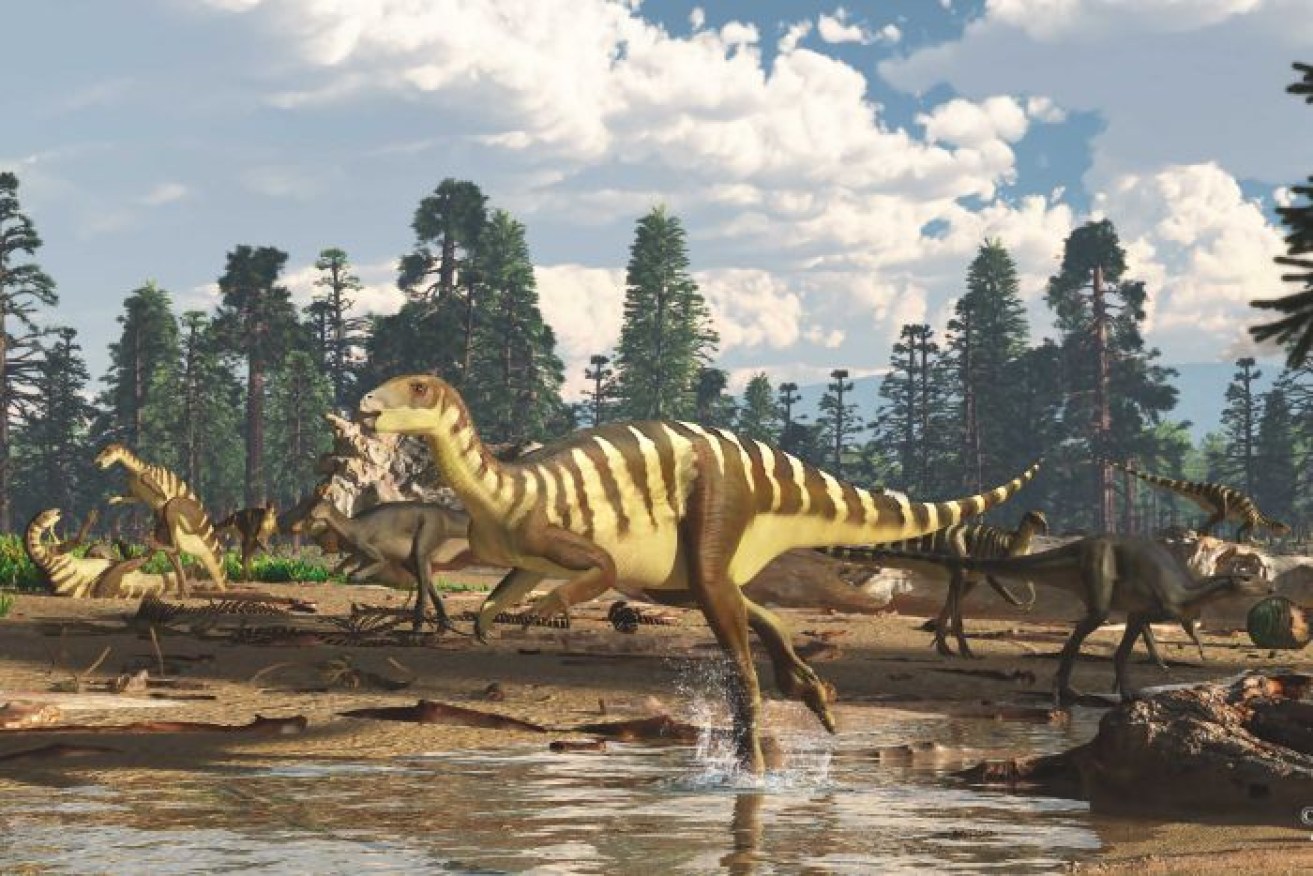New wallaby-sized dinosaur identified from fossils found along Victorian coast

Galleonosaurus dorisae lived in a lost world of lush forests in a massive rift valley. Photo: James Kuether
Fossilised jawbones found in rocks along Victoria’s Gippsland coast have been identified as belonging to a new species of plant-eating dinosaur the size of a wallaby that would have roamed the land between Australia and Antarctica.
Galleonosaurus dorisae is just the second dinosaur of its type to be identified from the 125 million-year-old rock platforms south-east of Melbourne – and the fifth from along the Victorian coastline.
Millions of years ago, this area was a lushly forested rift valley with a 4000-kilometre chain of volcanoes to the east, said palaeontologist Matthew Herne of the University of New England.
“It’s a lost world. None of this is now available or evident except for fossils, and the only place we can actually access these fossils is along the southern coast of Victoria,” Dr Herne said.

Fossils and 3D CT model of Galleonosaurus jawbone. Photo: Matthew Herne
Dr Herne and colleagues have spent the past 10 years carefully analysing fossils collected from the Flat Rocks area near Inverloch by other palaeontologists and volunteers from the Dinosaur Dreaming team.
Analysis of the fossils, published in the Journal of Palaeontology, indicate Galleonosaurus belonged to a large group of herbivores known as ornithischian – or bird-hipped – dinosaurs.
As the name suggests, these dinosaurs have hips that resemble modern birds, although the two groups are not directly related.
“We know it would have been a two-legged, quite agile plant-eating dinosaur,” Dr Herne said.
During the Cretaceous Period there were several species of small bird-hipped dinosaurs living around the edges of lakes and large rivers in the area.
“It seems that Galleonosaurus was no doubt closely related to possibly as many as four or five other species that look a little bit similar and were similar sizes,” Dr Herne said.
“But we can tell they’re different by the anatomy of the jaws and the teeth.”

Galleonosaurus was more gracile than other species found in the area. Photo: Matt Herne
“Micro CT allows us to actually peer inside the actual jaw and look at the structures internally,” Dr Herne said.
The different sizes indicate the dinosaurs were at different stages of development.
The jawbones were different to those of Qantassaurus intrepidus – the only other small plant-eating dinosaur of this type from the Gippsland region identified 20 years ago.
“Qantassaurus seems to have a much more beefy, robust jaw. It seems Galleonosaurus … had finer facial features.”
“This kind of suggests that we had different ornithopods that were possibly feeding on different types of plant material and might have inhabited different parts of the environment.”
The newly described dinosaur is also around 12 million years older than fossils of another small herbivore Diluvicursor pickeringi, which was found in the 113 million-year-old rocks along the coast of the Otway region to the south-west of Melbourne.
“The interesting thing about that whole coastline is it gives us a decent age range over quite a long period,” Dr Herne said.
Piecing together Australia’s dinosaur story
Piecing together the story of Australia’s dinosaurs has been challenging, said University of Queensland palaeontologist Steve Salisbury, who was not directly involved in this study.
“One of the issues has been there has been a lot of fossils of these sorts of dinosaurs found in Victoria on both sides of the coast since the late 1980s but nearly all the fossils that have been found, bar a couple of specimens, are isolated bits and pieces,” Dr Salisbury said.

The fossils were dug up by volunteers from the Flat Rocks area in the Bunurong Marine National Park of southern Victoria. Photo: Matt Herne
He said the discovery was a big step towards understanding the diversity of ornithischian dinosaurs in southern Australia.
“Within those two areas we’ve potentially got two different faunas that are separated by time,” Dr Salisbury said.
It can also help scientists understand where Australia’s dinosaurs fit into the global picture.
Australia, Antarctica and South America were once joined in a supercontinent known as Gondwana, which broke apart over time.
When Galleonosaurus was roaming the land, Antarctica and Australia were still joined together and connected to New Zealand via a massive volcanic ridge to the east.

Around 125 million years ago Australia was still joined to Antarctica. Map: Matt Herne et al
“We should see the same sorts of dinosaurs roaming across Australia, Antarctica and South America, but even though that’s what we should see we haven’t been necessarily been able to demonstrate it from the fossils,” Dr Salisbury said.
“And we’re just starting to be able to do that with this work that’s been published now.”
The discovery would not have been possible without the Dinosaur Dreaming team, he added.
“Every year there is a dedicated team of volunteers that go down there and they crack out bits of rock and split them into tiny bits looking for all these pieces and without that none of this would have ever have emerged.”
–ABC








